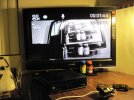- Joined
- Jan 27, 2013
- Messages
- 52,470
- Reaction score
- 30,344
- Location
- Sydney, Australia ~ Shenzhen, China
- Country
- Australia
- Dash Cam
- Too many ¯\_(ツ)_/¯
If it were for playback only, I would have expected it to be written as: Adjusts the camera’s frequency setting to minimize flickering and banding during playback on AV port.
.
if it were for playback it has nothing to do with flicker, you would get a black and white picture on the AV output if the setting was incorrect, if for playback then it should mention PAL/NTSC mode
Either Viofo messed up both the menu setting in the camera and the description in the manual, or the setting isn't properly working as BCHobbyist reports.
hard to say as the test he did won't demonstrate the problem anyway as flicker would happen regardless of the setting when looking at LED lights, check under incandescent lighting to see if the frequency setting is working or not


